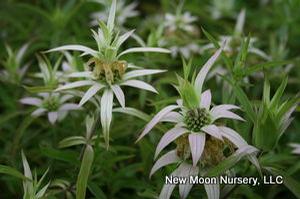New Moon Nurseries

Drought tolerant perennial, horsemint is good for rain gardens, restoration, meadow plantings, or use in the ornamental garden.
Monarda punctata
Horsemint
Native to North America
FIRST IMPRESSIONS: Monarda punctata is a multi-stemmed unbranched perennial wildflower. This beebalm bears narrow aromatic leaves on purplish stems. In summer, plants are topped by showy rounded clusters of creamy purple-spotted tubular flowers. Leaf-like pink, lavender or creamy bracts form beneath each flower cluster. The stacked combination of colored bracts and speckled flowers is unique and showy. Pollinators flock to the blooms in sunny prairie-like settings or in gardens with sandy well drained soils.
HABITAT & HARDINESS: Monarda punctata occurs from Quebec to Vermont and Florida and west to Ontario, Minnesota, Kansas and New Mexico.
This species is indigenous to sandy prairies and savannas, sand dunes around the Great Lakes and sandy fields. Plants occur in disturbed or high quality sandy habitats.
Plants are hardy from USDA Zones 4-9.
PLANT DESCRIPTION: Monarda punctata is an upright perennial with multiple stems and a few short rhizomes.
Stems are square and pubescent with brownish or purplish color. The aromatic leaves are arranged opposite from each other on short petioles along the stems.
Leaf blades are medium green and narrowly lanceolate. They are about 3” long and 1” wide with toothed edges and pointed tips.
The stems terminate in a series of rounded 2-3” clusters of tubular flowers. The corolla tubes are pubescent and creamy with violet dots.
The flowers are born in a ring on dense head-like cymes. Several pinkish, lavender or creamy yellow colored bracts are arranged beneath each cyme.
Blooming lasts for about 6 weeks and is followed by ovoid nutlets that are produced in brown button-like cymes.
Plants grow 1-3’ tall with 1’ spread.
CULTURAL & MAINTENANCE NEEDS: Monarda punctata thrives in full sun and dry sandy soil.
The species is considered to be a short lived perennial or biennial. Plants reliably emerge from dormancy for 2 years and may reseed after that.
The aromatic foliage is unpalatable to deer, rabbits and other herbivores.
LANDSCAPE USES: This is a good choice for a Wildlife Garden, Cut Flower Garden, or sandy Meadow. Plants are also used as Butterfly Nectar Plants or as part of a Grouping or Mass Planting. Monarda punctata has Showy Blooms and is appropriate for Cottage Gardens, Deer Resistant Plantings, Water-wise Landscapes, Low Maintenance Plantings and Perennial Borders.
COMPANION & UNDERSTUDY PLANTS: Try pairing Monarda punctata with Aster laevis, Asclepias tuberosa, Bouteloua curtipendula, Rudbeckia hirta, Liatris aspera, Penstemon digitalis, Schizachyrium scoparium and Andropogon gerardii.
Blephilia ciliata has similar appearance and culture and could be substituted in some situations.
TRIVIA: Monarda punctata has more of the aromatic beneficial phenol thymol than other members of the Mint family.
Plant have been used medicinally for horses as well as humans. For this reason they are sometimes called spotted horsemint or dotted horsemint.
Butterflies, skippers, hummingbird moths, hummingbirds, honeybees, bumblebees and other native bees sip nectar from the flowers. Caterpillars of several moth species feed on the foliage. The aromatic leaves and stems are unpalatable to deer and other herbivores.
The unusual pagoda-like flower arrangement is called a “verticillaster”. This floral composition occurs in only a few Mint family species. Most Monarda spp. have one terminal cyme per stem instead of this layered arrangement of cymes and colored bracts.
Height:
1-3 ftSpread:
9-12 inUSDA Hardiness Zone:
4-9Bloom Color:
Cream, PurpleMonarda punctata Characteristics
Attracts Wildlife
- Pollinators
- Hummingbirds
- Butterflies
Attributes
- Drought Tolerant
- Dried Flower
- Cut Flower
- Naturalizing
- Fragrant
Exposure
- Full Sun
Deer Resistant
- Deer Resistant
Flowering Months
- July
- June
Foliage Color
- Green
Juglans nigra Tolerance (Black Walnut)
- Yes
Soil Moisture Preference
- Moist to Dry
Interesting Notes:
For more information on this plant, visit the USDA PLANTS Database: http://plants.usda.gov/java/profile?symbol=MOPU